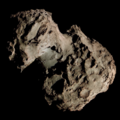 Comet SWAN in an outburst as photographed on 22 October 2006 | |
| Discovery | |
|---|---|
| Discovered by | Robert D. Matson Michael Mattiazzo |
| Discovery site | SOHO (SWAN) |
| Discovery date | 20 June 2006 |
| Orbital characteristics [1] [2] | |
| Epoch | 10 November 2006 (JD 2454049.5) |
| Orbit type | Oort cloud |
| Aphelion | ~9,800 AU (inbound) ~2,640 AU (outbound) |
| Perihelion | 0.783 AU |
| Semi-major axis | 1,300 AU |
| Eccentricity | 0.9998 |
| Orbital period | ~340,000 years (inbound) ~48,000 years (outbound) |
| Inclination | 111.82° |
| 148.73° | |
| Argument of periapsis | 62.594° |
| Last perihelion | 28 September 2006 [3] |
| Earth MOID | 0.070 AU |
| Jupiter MOID | 1.089 AU |
| Physical characteristics [2] | |
| Comet total magnitude (M1) | 11.0 |
| 4.0 (2006 apparition) | |
C/2006 M4 (SWAN) is a non-periodic comet discovered in late June 2006 by Robert D. Matson of Irvine, California and Michael Mattiazzo of Adelaide, South Australia in publicly available images of the Solar and Heliospheric Observatory (SOHO). These images were captured by the Solar Wind ANisotropies (SWAN) Lyman-alpha all-sky camera on board the SOHO. The comet was officially announced after a ground-based confirmation by Robert McNaught (Siding Spring Survey) on July 12. [4]
Contents
Although perihelion was reached on 28 September 2006, [3] the comet flared dramatically from an outburst, resulting in its apparent magnitude to increase from 7.0 to 4.0 on 24 October 2006, becoming visible with the naked eye. [5] [6]

